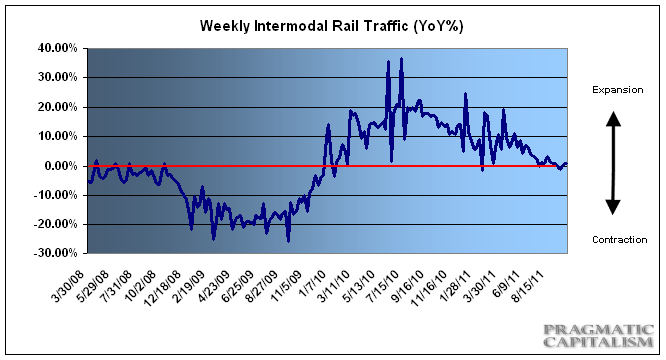The latest rail traffic data from the AAR showed a bit of a mixed bag with moderate declines in carloads and a slight annual increase in intermodal traffic. All in all, it’s about in-line with the readings we’ve been getting for the last few weeks. This appears consistent with recent economic data which implies a weak economy, but not cratering as you might expect from watching markets in some regions of the world. The AAR reports:
“The Association of American Railroads (AAR) today reported a mixed results in weekly rail traffic, with U.S. railroads originating 299,914 carloads for the week ending September 17, 2011, down 1.4 percent compared with the same week last year. Intermodal volume for the week totaled 242,250 trailers and containers, up 0.9 percent compared with the same week last year. This weekly volume is the highest since Week 40 of 2008.
Eleven of the 20 carload commodity groups posted increases from the comparable week in 2010, including: petroleum products, up 19.2 percent; lumber and wood products, up 14.8 percent, and metals and products, up 12.8 percent. Groups showing a decrease in weekly traffic included: grain, down 17.6 percent; primary forest products, down 12.5 percent, and nonmetallic minerals, down 10.1 percent.
Weekly carload volume on Eastern railroads was down 5.6 percent compared with the same week last year. In the West, weekly carload volume was up 1.5 percent compared with the same week in 2010.
For the first 37 weeks of 2011, U.S. railroads reported cumulative volume of 10,711,775 carloads, up 1.7 percent from the same point last year, and 8,381,960 trailers and containers, up 5.5 percent from last year.”
Source: AAR
Mr. Roche is the Founder and Chief Investment Officer of Discipline Funds.Discipline Funds is a low fee financial advisory firm with a focus on helping people be more disciplined with their finances.
He is also the author of Pragmatic Capitalism: What Every Investor Needs to Understand About Money and Finance, Understanding the Modern Monetary System and Understanding Modern Portfolio Construction.


Comments are closed.